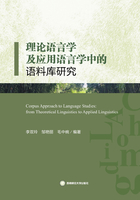
2. Literature review
1)Corpus-based translation studies
Corpus-based and corpus-driven studies of translation attribute to Corpus Linguistics. Compared with translatology, translation corpus studies are much younger. The book Corpus Linguistics and Translation Studies:Implications and Applications published by Mona Baker in 1993 was a salient ground in this area. And in 1995, Baker co-funded the Transitional English Corpus (TEC)with her colleagues. To date, corpus translation studies have focused on many areas:translator style (e.g. Hou, Liu&Liu,2014; Hu,2017), DDL translation teaching(e.g. Qin&Wang,2007), corpus-based critical translation studies(e.g. Xiao,2005; Hu,2017), lexical features of translation (e.g. Wang & Hu,2008)and translation universals(e.g. Wu &Huang, 2006).
Corpus-based translation studies are rapidly advancing over the years. Since the 2007 International Conference and Workshop on Corpora and Translation Studies mainly concerned about the significance of establishing and studying translation corpora; corpora and linguistic features of translation; corpora and translator style; and corpora and translation teaching (cf. Hu, Wu & Tao,2007), new research objects have expanded subsequent. Huang and Wang(2011)asserted that corpus translation studies had shifted to areas like the valuability of translation universal, the explanation of translator style or translation style, and the corpus-based exploration of linguistic changes in translation.
For instance, Liu, Liu and Zhu (2011)conducted a corpus-driven study of the translator style in four English versions of Dream of the Red Chamber at levels of lexicon and syntax. The study compares different translation versions of the same original text of an author. Furthermore, Hou, Liu and Liu (2014)investigated Goldblatt's translator style in a Chinese-English parallel corpus of his eight works of Chinese novels, five of Mo Yan and three of Su Tong included. Through a comparative analysis of the results of various statistical parameters, they found that all Goldblatt's translations share some similarities, apparently characterized by American English modes of expression.
2)The Chinese images of “donkey”
Donkey, a kind of ancient cattle, is a significant culture-bound symbol in literature between western countries and China. Sima Qian, the Western Han Dynasty historian, insisted that donkeys were Hun breed which appeared China in the early Han Dynasty and then were fed by the commonplace. However, sharply contrastive to the good“horse”, “donkey” was seen as an despising, obtuse, coward and ugly animal even until the Southern Dynasties. The trend to ride donkeys popularized among scholars in the Wei-Jin period, and “donkey” was somehow not as disdainful as before. Additionally, “donkey” began showing in some fantastic stories because of some alchemists, dotted with mystique. After Tang Dynasty, “donkey” were magnified, symbolizing the political appreciation and derogation of a person, the irony of the present times, or the comedown of a great scholar. As the case of Three Commandments, Tang Dynasty writer Liu Zongyuan, told an allegorical story about donkeys, mice and elks, aiming to sharply criticize those arrogant, swaggering and pretentious figures at his time.
There are some indications that Mo Yan intends to signify the evil humanity, one's personality or fate and the wired atmosphere by “donkey”. In the case of Life and Death Are Wearing Me Out, Mo Yan depicted a feudal landlord who experienced five times'death and his first life was a donkey. The book presented a most rebellious and wildest“donkey”that was extremely obsessed with“land” and “freedom”, for which it bravely fought with two wolves, argued with the village cadres, and even spent its last moment by the river. Though the “donkey” was dissolute, unconfined, stubborn and hassling, readers could feel its strong eagerness of being respected and recognized as a living life. However, in The Republic of Wine, “donkey” was just pieces of flesh, no any smallest sign of eagerness, thoughts, or even consciousness. The most famous Donkey Avenue in Liquorland was actual a large, filthy, bloody and horrible abattoir for donkeys. In The Red Sorghum, “donkey” was meek, quiet, smart and hard-working, yet sometimes it was so recreant and dull that annoyed its master.